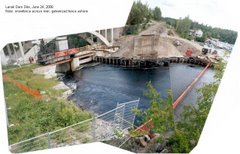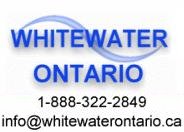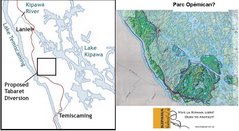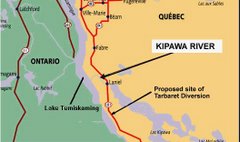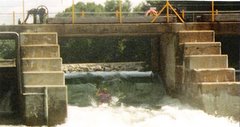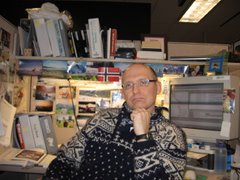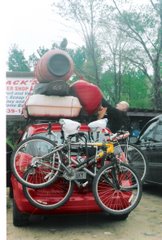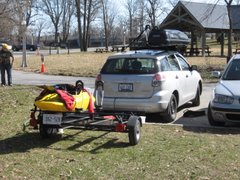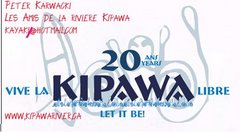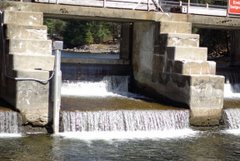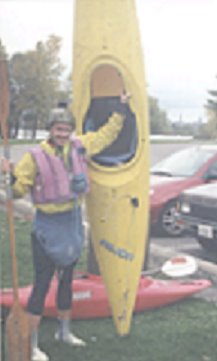Hermann & Christa Kerckhoff
(613) 234-2065 200 Lett St Ottawa ON K1R0A7Hermann Kerckhoff
Gender: Male
Height: 6'3" (190 cm)
Weight: 176 lbs (80 kg)
Born: December 27, 1937 (Age 75) in Berlin, Berlin, Germany
Country:
 Canada
Canada
Sport: Canoeing
http://www2.canada.com/ottawacitizen/story.html?id=462c3edd-4590-460b-83fd-611739c12aa6
Barry's Bay and MKC became the home of the world's first commercial whitewater school
AW article
My first memory of whitewater is having to jump into it ! I was three and my parents forgot me on an island in the middle of the Lower Madawaska River after portaging their gigantic double-seater, canvas, folding kayak around Rifle Chute. Impossible to get back to me… they asked me to jump in and float down into their arms. As diligent parents, I did have my PFD on….and as a trusting little one, I did what I was told, and loved it!!
Now at 50, I still love the thrill, freedom and intensity of whitewater … Just returned from an amazing seven days of kayaking in Ecuador with my ‘whitewater husband’ - I thank my parents for their unique introduction.
I also feel privileged to have bridged 3 generations of whitewater paddling in North America…as my parents were amongst the pioneers of the Sport. I held the Canadian championship title for ten years and secured a Bronze medal at the World Championships in whitewater slalom. Then transferred my racing career to our family businesses – Madawaska Kanu Centre and OWL Rafting on the Ottawa River. And we feel very fortunate that both our daughters have made the Sport their own…Stefani as of the young age of 16 has been guiding from her Open Canoe on Northern rivers, with Katrina now 20 enjoying the bigger waters from her kayak, and presently training full time for the 2012 Olympic Games .
As pioneers, my parents have a list of firsts… first kayak descent of the Grand Canyon as a part of the epic 42-member Walt Blackadar expedition back in 1968, first kayak descent of the Ottawa River in 1974 with me **, competing for Canada at the first-ever Olympic Games in 1972, and also in 1972 - after the Olympics in August of that year, as not to loose their amateur status - starting the first commercial whitewater paddling school … in the World ! If you count the years since then, you’ll need four sets of hands and realize that this year…2011 is Madawaska Kanu Centre’s 40th Birthday.
In the early days, “Madawaska” or referred to as MKC hired World Whitewater Champions from Europe – as guest instructors. This included great names like Norbert Sattler, Gerhardt Peinhaupt, Gisela Grothaus and Bernd Heineman in C-1. The first few years MKC was more of a slalom training camp – actually called Kanu Camp. But, my parents quickly changed gears, realizing that there was a finite group of slalom paddlers, most had now attended the school, and focused on creating skill level classes. Thus, from the onset, MKC’s signature structure of dividing students into skill level classes, allows couples, families and friends to vacation together, but challenged at their own levels – providing an incredible learning environment for all.
These early champions were also my early instructors…a bit of a home advantage I guess, but I fell in love with the sport quite young. Had my first kayak…a bright yellow lady bug design made in our own basement at the age of 7. . We were all round paddlers back then, not specialists as found today. This was a little easier as there was only one kayak design – a 4m (13foot) kayak, round hull, pointy tips with good leg room. They
had by now changed over to fibreglass, but this too could be looked upon as an advantage – we were forced to avoid the rocks, place your kayaks in the water, and negotiate around obstacles in order to not break them. I recall us having a fulltime staff member just for repairs - patching the multiple holes or stress fractures that occurred daily. Instructor, Uli Kluth’s response to his rescue technique …” my boss in Germany said the boat costs money, the student can swim “.
Austrian, Norbert Sattler came to MKC the year after winning Olympic Silver in Augsburg – the first ever artificial course – dancing his way down the technical rapids of the Madawaska River and dropping into holes to side surf. He was again pushing the envelope for kayaking. Dropping into the biggest on our section called “Gravelpit Suckhole” – started twirling his paddle and smiling yelling “Ich bin der Beste” and became the first member of the now infamous club that has over 450 member names wood-burned onto disks of sumac proudly displayed in the MKC Chalet.
The Chalet too has it’s own history. Originally built small as our family cottage -if a whitewater school had not succeeded - housing all under one roof…the kitchen, dining room, library, lounge area with our comfy beanbags, and upstairs two dormitories housing 17 men and 9 women at the time. Expanded in the nineties the Chalet no longer is a sleeping area, but still the hub of activity. It is a stunning building with it’s own Canadian ‘river history’ built out of t beams, retrieved after the Ottawa River log drive was shut-down in the eighties. The kitchen is still at the centre of anyone’s MKC experience. Serving delicious meals – hearty, healthy and locally grown, it is always the first memory shared when asked how was your MKC course … wow, the food was amazing ! “
We will be celebrating four generations of introducing whitewater to now thousands …maybe hundred thousands all summer long at MKC and OWL Rafting on the Ottawa…starting with returning alumni discounts, and then a slew of events…
* A Raft, Paddle & Lobster Event, Friday June 24th
* Voyageur Heritage Weekend, June 11/12 - reliving history, by paddling & rafting the same rapids that 400 years ago was the hwy into our countries interior * Staff Reunion, August 13/14th – please sign on to www.myevent/ if you have worked with us, and haven’t yet heard about this great event !
So much fun to share a part of my history with the readers of AW – a magazine that has been a vibrant contributor in keeping our sport of whitewater paddling alive.
*whom I met in an Eddy on the steep drops of the Gull River in Minden Ontario…
**My father and I at 14 ventured down the unknown, based on a tip two local brothers gave us who ran a survival school on Calument Island… we became the first to discover that their were still rapids on the gigantic Ottawa, not flooded by one of the 43 dams along it’s 1100km course. A whitewater paradise was discovered and now I know that the river level that day was 9 on the gauge, as the hydraulic I got stuck in below Butchers Knife only comes in at this level J
***- a wonderful collection of books and magazines from the sixties to the present, including American Whitewater magazines from the onset !
**** It took awhile to realize that the bark falling off the thousands of logs floating down our rivers had suffocated the riverbeds.
This is from Tom SPears article in the Ottawa Citizen
Making a big splash
Steeped in history, the Madawaska Kanu Centre, Canada's first whitewater paddling school, is celebrating 40 years in business. Tom Spears got the chance to visit one of the loveliest stretches of whitewater in the country
Tom Spears, Ottawa Citizen
Published: Saturday, September 10, 2011He didn't want any such permission for his whitewater canoe and kayak school. If he built on the Madawaska River, he told the officials, then all kinds of other development would follow.
Soon one of Canada's loveliest stretches of whitewater would be crowded with cottages, souvenir shops, gas stations, and who knows what.

Student Sylvia Hurdle conquers the whitewater of the Madawaska River. The Madawaska Kanu Centre has just celebrated its 40th year of operation.
Chris Mikula, The Ottawa Citizen
They gather in their bright-coloured plastic canoes and kayaks, either on shore or in sections of quiet water where a group of boats can come together. Then they paddle out into a series of rapids separated by sections of calm water.
Today Claudia Kerckhoff-Van Wijk and her husband Dirk Van Wijk own and operate the centre; they bought out Hermann and Christa Kerckhoff, Claudia's parents, in 1988.
They run five-day courses from Monday to Friday, and two-day weekend courses. The main focus is on the five-day course, typically bringing 30 to 50 students in kayaks and open canoes.
(Canoeists tend to come early in the season to prepare for northern river trips; kayakers wait for the water to warm up. They're going to spend a lot of time in it.)
The bottom of this stretch of river is the least challenging, so students begin there and move to the more turbulent water of rapids upstream as they learn. It's the perfect design.
"Nature helped us with this," Claudia says. The centre shifted some rocks in one set of rapids, which required permission from the Ministry of Natural Resources, but the ministry concluded the changes would improve fish habitat, and gave its blessing.
But while the river's course is almost unchanged over the years, the water level is man-made. MKC is just below an Ontario Power Generation dam. The dam doesn't generate power, but regulates the flow out of Bark Lake to other hydro dams and the town of Arnprior downstream.
It's this dam that allows the school to operate.
Ontario rivers tend to slow down in the prime tourism months of July and August. Rapids become quiet little streams. But in the very beginning, Hermann Kerckhoff made a deal with the former Ontario Hydro: the dam releases more water in the day and less at night in order to create the best whitewater. Water gushes through for six and a half hours a day from Monday to Thursday at a minimum rate of 26 cubic metres per second, while at night the river becomes gentler, as little as three cubic metres per second. (On Fridays the students are taken to other rivers.)
Published: Saturday, September 10, 2011
That arrangement is now part of the Madawaska Management Plan.Claudia reflects on how the school came into being almost as an afterthought.
"When my parents started (the centre), they just wanted to get more people interested in whitewater paddling. They had no idea they started the first whitewater school in the world."
Hermann wanted to be a Canadian lumberjack and came to Toronto at age 18. It wasn't exactly lumberjack country, but he still managed to go out and explore nature.
"He loved everything about Canada, except the women couldn't cook. He wanted a German wife," his daughter recalls.
He sailed back to Germany, married Christa, and brought her to Canada just weeks later. She thought she was seasick on the voyage across, but she turned out to be pregnant. Claudia was born in 1962 and two sisters followed later.
Christa was a chartered accountant, and met an Austrian woman at her office in Toronto who enjoyed kayaking and introduced the young couple to the sport.
Hermann knew something about paddling already; he had paddled the length of the Rhine River in a collapsible, canvas-covered kayak. The couple started competing ("My parents are very competitive," Claudia says). By 1968 they were men's and women's Canadian paddling champions, respectively.
They were thrilled. But what do you do once you're a champion?
The only thing to do was to start a school, based on the notion of a European ski school, while Hermann also operated a flooring business in Toronto. (Claudia again: "My parents are very entrepreneurial.") The Madawaska Kanu Centre opened in 1972.
Fine, but why Kanu?
It's the German spelling, but there's a twist.
Kanu doesn't mean canoe in German. It means kayak.
"All over the world when you say 'canoe,' even in England, they mean kayaking," says Claudia. "If you mean an open canoe, they call it 'a Canadian.'
"So when my parents came up with the name, how perfect is that? It means canoe and kayak in one word, and it gives it a European twist."
-
You don't need to do much to a river to make it a classroom, but there are a few additions.
Ropes hang overhead across the Madawaska, with coloured poles dangling from them. These are gates, like the slalom gates on a ski hill. They're also make-believe rocks for those learning to run the river; "it hurts a lot less to hit one of these than to hit a real rock," says Claudia.
Yes, rocks. Big ones. Students wear helmets for a reason. The canoes are Kevlar-enforced too, but even so, they only last about two years.
(Claudia has a tip for anyone going down rapids without a boat, which usually happens by accident: go feet first, with the feet and head up and the rear end down. That way, the body part most likely to hit bottom is padded.)
She watches two young brothers from Washington, D.C., who are sitting in a calm eddy halfway down a set of rapids, watching the rushing water on all sides a little anxiously.
Published: Saturday, September 10, 2011
"And" - she pauses to watch them move into the current - "they almost fell in. But they didn't let go of their blades (paddles) and they didn't panic, so they made it."
A lucky quirk of the river in the five-kilometre stretch used by the centre: it's warm.
Students come from Denmark and Australia and many more countries. Traditionally some 40 per cent have been Americans, though the strong Canadian dollar and weak U.S. economy have hurt numbers.
Many are young; one class last week ranged in age from 10 to 60. "Children learn faster," Claudia says. "We (adults) think too much. Kids just do it."
KANU CENTRE MADE FOR TEACHING, BUT OWL RAFTING PURELY RECREATIONAL
Tom Spears
laudia Kerckhoff-Van Wick and Dirk Van Wijk run two parallel operations: Madawaska Kanu Centre and the much larger OWL Rafting on the Ottawa River, which is 30 years old this summer.
OWL offers a 12-kilometre trip down the Rocher Fendu rapids from Foresters Falls, near Cobden. It's a six-hour trip, and purely recreation, not a school.
Madawaska Kanu Centre takes in about 2,000 canoe and kayak students and 5,000 rafters per season, while OWL Rafting carries close to 20,000 rafters.
There are about 100 employees, including a few who work during the off-season in marketing and making the round of boat shows and sportsmen's shows.
Parents Hermann and Christa created the Madawaska and OWL centres, but by 1988 they felt the challenge of created and building was over. They sold the business to Claudia and Dirk and now, in their early 70s, are retired. Today Claudia is 50 and Dirk is 51.
The Kanu Centre remains the heart of the enterprise, even though it's smaller. Here is where the couple lives in summer, where they raise hens for eggs and a herb garden for the meals they serve hungry kayakers. (It suffers for lack of sun, but that's life in the forest.) They spend the winters in Ottawa.
OWL Rafting also has chickens (for meat, not eggs) and pigs, which eat just about anything and reduce the amount of garbage by 25 per cent.
Madawaska Kanu Centre has a range of accommodations, including a campground for those on a budget.
Prices for a five-day course range from $500 (for instruction only) to $975 with meals and accommodation in the lodge. Rentals of boats and equipment are extra.
Claudia is a 10-time Canadian National Whitewater Kayaking champion and was a bronze medallist in the World Championships in 1982. Dirk is a three-time Canadian champion in the C1 (single paddler) canoe class.
In summer Claudia lives on the Madawaska property, and Dirk is based at OWL, though they visit back and forth. "Seasonal separation," Claudia jokes.
Already the family is looking forward to the next generation. Claudia and Kirk's daughters Katrina, 21, and Stefani, 19, are serious paddlers as well. Stefani is a canoe guide with Black Feather and Katrina is training to be on Canada's 2012 Olympic slalom kayak team, which will be chosen in April.
"Both of them do it for themselves," Claudia says. "We're just elated that it has worked out."
© Ottawa Citizen 2011
Christa and Hermann Kerckhoff were drawn from Germany by the lure of the open, northern wilderness in the late 1960s. Pioneers in white-water kayaking, they soon established the Madawaska Kanu Centre south of Barry's Bay, teaching the fine art of paddling safely in rough water. In 1974, Hermann took his young daughter Claudia on one of the first kayak trips through the infamous Rocher Fendu, 12 kilometre-long rapids on the Ottawa River south of Pembroke. Many men died here during the logging era; pioneers of that period could never have imagined that six companies would be established to serve thousands of tourists eager to pay for the privilege of voyaging through the white water in rubber rafts, canoes and kayaks. One of the companies is Owl Rafting at Foresters Falls, run by Dirk Van Wijk, an international white-water champion, born in Holland, and husband of Claudia, who now manages the Kanu Centre. A staff of about 100 is hired each season, half white-water experts from all over the world and the remainder local people. For more information, visit www.owl-mkc.ca.Madawaska got its start in 1972, the year that co-founder Hermann Kerckhoff competed for Canada at whitewater’s inaugural Olympic Games. Returning home that August he and his wife Christa - also a Canadian women’s whitewater champion, opened the doors to Canada’s first whitewater school – a dream fulfilled as they would share their passion for whitewater paddling with North Americans. The school was built on the European ski-school concept that the Kerckhoff’s were familiar with from their German routes – having paddlers learning in skill–specific classes, with top-notch instructors in a natural river setting, comfortable environment that boasted a strong emphasis on healthy, hearty food, and a warm après paddling atmosphere. Madawaska continues this same tradition today serving first class cuisine, relaxing after paddling in the stunning post’n beam chalet and enjoying on-site yoga, massage therapy, with internationally renowned instruction and a progressive learning environment.
It has been an exciting road since starting Madawaska Kanu Centre, Canada’s first whitewater
paddling school in 1972. Carving out a unique program, that combines structured learning in a
resort environment with a twist of European flare; entrepreneurs and national whitewater
champions Hermann and Christa Kerckhoff learned that they were pioneers in their field.
Years later they discovered they had started a phenomenon - the first commercial whitewater
school in the world !
Hoot of a history with OWL Rafting
Steve Newman, Renfrew Mercury - Wednesday, July 06, 2011
Claudia and Dirk Van Wijk have both been intricately involved with world-class and adventure sport. From a young age, both had those experiences with the help of their parents.Years later, the Van Wijks find themselves in a similar situation. Daughter Stefani is a fourth-year guide with Black Feather Wilderness Adventures, and daughter Katrina is training for the 2012 Olympics in whitewater slalom kayaking.
“The apple doesn’t fall far from the tree,” says Claudia while relaxing at the business, OWL Rafting, that is owned by herself and husband Dirk.
“We are so lucky that our children have fallen in love with what we do as a living, from cross-country skiing to paddling. Both girls have fallen in love with Dirk’s and my passion.”
So many chapters of the couple’s history has been deeply connected to adventure on snow or water.
For example, Dirk was chief of course preparations for the 2010 Winter Olympics for nordic combined and cross-country skiing.
His own racing experiences include the 1979 world junior cross-country ski championships. Claudia was a 10-time national whitewater kayak champion. Also, at age 14 she and her dad (Hermann) became the first to kayak the rapids of the Ottawa River just north of where OWL rafting is located.
Fast forward to 2011, and Claudia is giving a tour of the OWL Rafting facilities for a visitor. She passes a series of their cabins that are each named after rapids on the Ottawa River where OWL Rafting rafts, canoes and kayaks do business every day of the summer. The cabins’ names include Coliseum, Roller Coaster, Push Button, Muskrat, and Black Chute.
Claudia planned to be a dentist. But life took her in another direction.
“It’s unique to be an athlete at a high level and shift their athletic career into their business career,” she says.
Their business also have a sense of continuity.
MKC, Canada’s first white water school for kayaks and canoes, is on the Madawaska River just south of Barry’s Bay.
OWL Rafting is located on 25 acres, just outside Foresters Falls, where it offers a variety of paddling, rafting, camping and culinary opportunities.
This year, OWL Rafting and MKC are celebrating their 30th and 40th anniversaries respectively.
The very beginning happened, innocently enough, shortly after Claudia’s dad attended the Toronto Sportsmen’s Show and met the Lamothe brothers from Calumette Island who were running a survival school. They bragged about the huge whitewater in their own backyard.
Soon after, the river became a training destination for MKC weekend sessions.
Claudia’s dad was Hermann Kerckhoff, who competed at the 1972 Olympics in Munich.
Claudia qualified for the family’s second Olympic berth, for the 1992 Games in Barcelona where she would have been gunning for a medal.
But by the time the ’92 Games came along, she had retired from racing. Along the way, Claudia and Dirk finished bachelor’s degrees in business from Ottawa universities.
The couple, which was married in 1985, had purchased the whitewater businesses (OWL and MKC) from Claudia’s parents (Christa and Hermann Kerckhoff), so it was time to take care of life after athletics. There was plenty to do, including the molding and modifying of OWL Rafting.
In the beginning, in the early 1980s, OWL was more a party destination for bus loads of Toronto-area residents. But they soon decided that wasn’t how the company would shine, and the move was started to focus on catering to families.
The focus became people coming to the river for the right reasons, as Claudia puts it, “for the nature, for the river, for the experience.”
And the move has paid off.
With this philosophy the Van Wijks have incorporated a sustainable, green policy that includes composting all food and excrement at OWL rafting, with the help of two large $20,000 bins that work in symphony with thousands of red-wiggler worms.
Visitors at OWL Rafting can also camp overnight while enjoying food prepared on site and the recreational options, among them disc golf, swimming and beach volleyball.
But the main draw remains, for most, what it long has been – the whitewater experience on the river whose water volume, velocity and waves rival those of the Colorado River, but with whitewater that is warmer and interspersed with quiet pools and sandy beaches.
Within a 90-minute driver, customers can also visit MKC, located on the Madawaska River between Bark Lake and Kamaniskeg Lake.
Kayaking and open canoe instruction is available for paddlers at MKC at all levels. Services include first-class cuisine in its post-and-beam chalet, a paddling equipment store, lodging, yoga sessions and massage therapy.
The two facilities also feature instructors from overseas and North America, including 2008 Olympian Sarah Boudens of Pembroke. This year’s instructors reign from such countries as Argentina, Australia, Germany and Norway.
The company’s legacy, hope Claudia and Dirk, is leaving the river settings unmarked and appreciated by educated clientele and getting more bums in boats.
A landmark service is the pontoon boat ride back to OWL, following the river rafting experience, while enjoying a meal and conversation.
Activities during this year’s anniversary celebrations include a July 1-3 customer appreciation weekend and Aug. 13-14 reunion with many of its more than 1,000 staff members over the years.
For details, visit the website of www.owl-mkc.ca
steve.newman@metroland.com
http://publishing.yudu.com/Ac3ad/OOM-SprSum08/resources/52.htm
http://news.google.com/newspapers?nid=1946&dat=19790616&id=rIIuAAAAIBAJ&sjid=T6EFAAAAIBAJ&pg=3508,727993
Bark Lake Water Managerment Plan
White-water Minimum Flow
25.6 m3/s
Note of interest
This minimum flow is not a compliance limit. The recreational flow is released according to the following guidelines.
1. The date is within the white-water release period. The white-water release period starts on the Monday of the week of Mid
May and ends on a Thursday of the last partial week of August.
2. The day of the week is Monday to Thursday, excluding statutory holidays.
3. The time of the release is 08:00 to 14:00 EST. Log operations commence 45 minutes prior to the start time and 30
minutes prior to the end time.
4. When water management strategies require a release greater than 26 m3/s flows are not reduced during release time to
provide for ideal white-water conditions.
5. Flow releases are set at:
a) 26 hours per week when Bark Lake is above 313.62 m.
b) 18 hours per week when Bark Lake is between 313.62 and 313. 50 m.
c) 0-18 hours as required for downstream minimum flows when Bark Lake is below 313.50 m.









